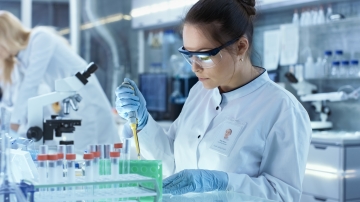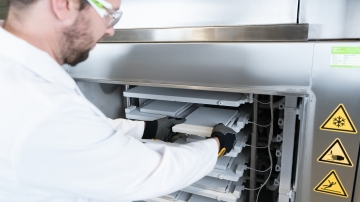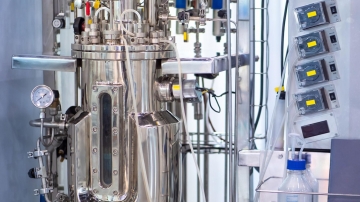Controlling cryogenic freezing with liquid nitrogen
Table of contents
ShowCryogenic freezing is a necessary process for the preservation of molecules, cells, genetic material, blood, and tissues. Single-use technologies enable protection of such substances from contamination and failure and preserve them for long-term storage as well as safe shipments. But, controlling cryogenic freezing can be quite a challenge, especially with liquid nitrogen (LN2).
Small molecules, e.g. of amorphous pharmaceuticals, must be kept chemically stable and hydrolysis reactions and chemical degradation have to be prevented. Room or ambient temperature influence the stability of proteins negatively, as the protein stability would decrease if proteins are stored at ambient temperature over a longer period of time. This can further lead to loss of functionality and degradation. Consequently, incorrect or improper handling of molecules, cells or other liquids jeopardizes the product quality of therapies.
It is common practice to freeze liquid medicine in order to keep them safe and stable. However, cryogenic freezing is not as simple as it may sound. The process of freezing cell lines is highly complex, because there are many obstacles that can occur. Due to the fact that vital cells are mainly made of water (60-95 %) and dissolved molecules, biotechnology companies face the risk of uncontrolled ice formation in cells, which leads to harmful degradation. Additionally, oversized extracellular ice crystals can emerge, which would cause osmotic stress as well as mechanical injuries of the cells.
However, other than during lyophilization (dry freezing) it is very unusual to strain the cells from water before starting the freezing process because this could result in collapsed or cracked cells due to disturbed osmosis. Lyophilization is another possible way of freezing cells, yet, the freezing rates are not easy to control, especially because conventional static freezers are used for lyophilization.
While some ice formation is simply inevitable, because of the high volumes of water contained in the cells, damaging levels of ice formation must be prevented. Controlled freezing and thawing processes are advised to limit osmotic stress and, hence, ensure cell viability after cryopreservation. Depending on the density and volume of cells in therapies, heat transfer rates and required temperature differ. Some products require freezing down to - 80 °C, while others require a much lower rate of, e.g. -150 °C. Therefore, every product group requires a specific and individual freeze-thaw-process and cycle so that viability, scalability, robustness and replicability are guaranteed. Freezing below -80 °C requires chemical substances like liquid nitrogen.
Why cryogenic freezing with liquid nitrogen?
It is common practice to perform cryoconcentration of specific drug substances or cells down to -180 °C. Since this is no longer possible with plate freezers, liquid nitrogen is most popular.
Liquid nitrogen is not only non-flammable, it is also noncorrosive, colorless and odorless. Additionally, liquid nitrogen is an extremely cold material and therefore perfect for freezing-processes. With liquid nitrogen, the freezing process is considered to be more flexible and quicker than with other, more traditional techniques, but at the same time, there are also a vast number of difficulties and challenges that occur when using liquid nitrogen for freezing.
Challenges with LN2 Freezing
Exposing liquids with LN2 to freeze drug substances may not be an easy task. However, there are hardly known pitfalls that may influence a safe and successful freezing procedures.
Costs
The price for liquid nitrogen is not extensively high, but uncontrolled freezing with LN2 lead to extensive and unnecessary use of LN2. Additionally, there are additional costs of delivery and storage, because dry vapor liquid nitrogen shipper are very bulky.
Sustainability
When cryogenic freezing is performed with uncontrolled use of liquid nitrogen, there is an extensive use of the liquified gas, which is results in a larger footprint.
But, due to the fact that freezing down to -180 °C is not possible with plate-based freezers, nor blast freezer, LN2 is (currently) the only actionable solution.
Control over freezing rate
Liquid nitrogen owns a very high freezing rate. This means that bags could actually be frozen within a few minutes. However, not all cells require the same freezing rates, quite the contrary. Because, different types of cells require controlled freezing, such as mammalian cells or other smaller molecules. Therefore, there is a high risk of decreased cell viability after freezing.
The recommended freezing rate for safe freezing is 1°C (1K) per minute. Freezing down too fast, can have negative effects, which is why it is so important to have controlled freezing processes. This is only possible with innovative tools such as the RoSS.LN2F, which enables freezing rates of 1°C (1K) per minute.
The solution is innovation
Traditional cryogenic freezers using LN2, such as dry vapor liquid nitrogen shipper have significant disadvantages. Containers are filled with LN2 and the product is placed inside to be shock frozen with extremely high freezing rates, which deteriorates the viability of smaller molecules, cells and so on.
When using platform freezers, one has no control over the amount of LN2 being used. This means, one either uses way too much LN2, which is neither cost-efficient, sustainable or effective during cryopreservation and transportation.

To achieve control over freezing with liquid nitrogen, Single Use Support developed the innovative freezer technology, RoSS.LN2F. It is an enclosed system that makes freezing cell and gene therapies controllable and economical in operations because the innovation is based on the fast cooling of chamber and subsequent continuous LN2 injection. Also, freezing with RoSS.LN2F makes the procedure fully scalable, and it works with the highest possible speed and accuracy for best product stability results.
RoSS.LN2F is powerful and can manage temperatures down to -180°C/-292°F. This new freezer technology is not only an innovative and helpful tool, it is also a way to change the future of cryogenic freezing with liquid nitrogen all together.









